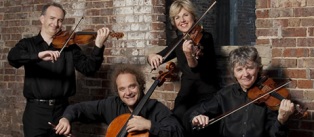
Takács Quartet Quartet Closes Chamber Music Cincinnati Season with Ardor
The ardor of Mendelssohn, the inventiveness of Haydn
and, of course, Bartok. This is what
Tuesday evening’s (April 5) Chamber Music Cincinnati concert by the Takács Quartet was
about.

Founded in 1975 in Budapest and one of the world’s
reigning string quartets, the Takács foursome performed before a capacity crowd
in Werner Recital Hall at the University of Cincinnati College-Conservatory of
Music. They brought a varied and well
chosen program spanning the 18th to the 20th centuries
and kept listeners engaged throughout (including several youngsters who
brought their parents free of charge as part of a new audience-building initiative
by CMC). It was the final concert of CMC's 2010-2011 season.
Haydn’s Quartet Op. 74, No. 3, called “The Rider,” is one of his most popular. So-named for the galloping rhythms of the finale, it also has a meltingly beautiful slow movement (Largo assai). Immediately evident was the finely calibrated voicing of the ensemble, which produced some gorgeous blends, as at the beginning of the Largo where the sound opened out into a big chord underlined broadly by cellist Andras Fejér. The Menuetto (Allegretto) was smooth and gracious and the finale, with its offbeat accents, brought smiles to their faces and those of their listeners.
Bartok’s Second Quartet is also one of his most often played and it got superlative treatment by the Takács (founding member/first violinist Gabor Takács-Nagy left the group in 1993 and was succeeded by violinist Edward Dusinberre of Great Britain). Fejér and the quartet’s newest member, American violist Geraldine Walther, applied a feather light touch to the opening bars of the plaintive Moderato where, again, balances were excellent. The second movement, Allegro molto capriccioso, reflects Bartok’s researches into Hungarian folk idioms and the players dug in with gusto, producing some of the evening’s most memorable moments.
The three-movement work, composed in the shadow World War I, ends with a poignant Lento. Playing was keenly expressive, beginning with a bleak interval by Dusinberre and second violinist Károly Schranz, building to a high point, then returning to the depths with two forlorn pizzicati by Walther and Fejér.
The quartet saved its love songs for last with Mendelssohn’s Quartet No. 2, Op. 13. Penned when the composer was just 18 and in love, it gushes with youthful passion. Dusinberre, who draws an astonishingly smooth, pure tone from his violin, made the first statement in the Adagio introduction of the touching recurrent theme, “Ist es Wahr?” (“Is it true?”). (The theme was taken from a song Mendelssohn had written earlier to verses beginning “Is it true that you are always waiting for me in the arbored walk?”) As the music grew more impassioned, the quartet was careful not to overplay, saving their lushest expression for the highly emotional second movement (Adagio).
The tripartite Intermezzo was straightforward and mellow by contrast. Walther did not project as well as her colleagues in the rapid spiccato (bounced bow) passages in the contrasting mid-section, but the effect was exhilarating. All of a young man’s complex feelings seemed to spill out in the last movement (Presto – Adagio non lento). Expression grew very dramatic here, with a long solo by Dusinberre on the “Ist es Wahr” theme leading into the final Adagio, which reprised material heard earlier before coming to a gentle end.
Chamber Music Cincinnati’s 2011-2012 season was announced before the concert by board of directors president Kayla Springer. It will open Sept. 20 with the Juilliard String Quartet. Ensembles and programs are:
- Sept. 20. Juilliard String Quartet. Stravinsky, Three Pieces for String Quartet (1914, rev. 1918). Leos Janacek, String Quartet No. 1 (“Kreutzer”). Mozart, String Quartet in A Major, K. 464.
- Oct. 18. St. Lawrence String Quartet. Mozart, String Quartet in D Minor, K. 421. Erich Korngold, String Quartet No. 3 in D Major, Op. 34. John Adams, String Quartet (2008).
- Dec. 6. Alfiara String Quartet. Beethoven, Quartet in F Minor, Op. 95 (“Serioso”). Carl Nielsen, Quartet No. 4 in F Major, Op. 44. Sibelius, Quartet in D Minor, Op. 56 (“Intimate Voices”).
- Jan. 10, 2012. Los Angeles Piano Quartet. Mozart, Piano Quartet in E-flat Major, K. 493. Steven Stucky, Piano Quartet (2005). Gabriel Faure, Piano Quartet in G Minor, Op. 45.
- March 20, 2012. Morgenstern Piano Trio. Debussy, Piano Trio in G Major (1879). Leonard Bernstein, Piano Trio (1937). Brahms, Piano Trio in B Major, Op. 8.
- April 24, 2012. Kaplan-Weiss-Newman Piano Trio. Clancy Newman, “Juxt-opposition.” Beethoven, Piano Trio in G Major, Op. 1, No. 2. Jennifer Higdon, Piano Trio (I. Pale Yellow; II, Fiery Red). Brahms, Piano Trio in C Minor, Op. 101.
All concerts are at 8 p.m. in Werner Hall at CCM, except March 20, which will be at First Unitarian Church, Linton and Readings Roads in Avondale. Information at www.cincychamber.org